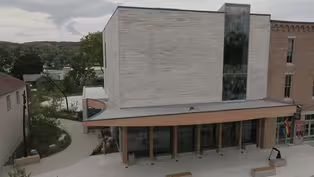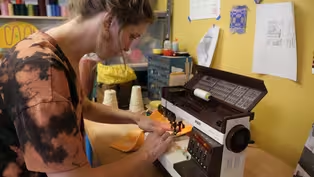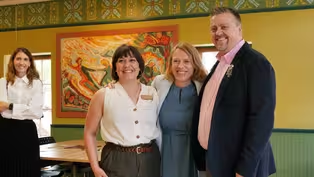
Nora Taksdal - A Norwegian Viola Player
Clip: Season 15 Episode 10 | 11m 39sVideo has Closed Captions
Nora Taksdal plays the viola and is the principal violist of the Norwegian Radio Orchestra
Nora Taksdal plays the viola – the slightly larger sibling of the violin – and is the principal violist of the Norwegian Radio Orchestra based out of Oslo, Norway. The Norwegian Radio Orchestra was founded in 1946 and currently consists of 54 musicians.
Problems playing video? | Closed Captioning Feedback
Problems playing video? | Closed Captioning Feedback
Postcards is a local public television program presented by Pioneer PBS
Production sponsorship is provided by contributions from the voters of Minnesota through a legislative appropriation from the Arts and Cultural Heritage Fund, Explore Alexandria Tourism, Shalom Hill Farm, Margaret A. Cargil Foundation, 96.7kram and viewers like you.

Nora Taksdal - A Norwegian Viola Player
Clip: Season 15 Episode 10 | 11m 39sVideo has Closed Captions
Nora Taksdal plays the viola – the slightly larger sibling of the violin – and is the principal violist of the Norwegian Radio Orchestra based out of Oslo, Norway. The Norwegian Radio Orchestra was founded in 1946 and currently consists of 54 musicians.
Problems playing video? | Closed Captioning Feedback
How to Watch Postcards
Postcards is available to stream on pbs.org and the free PBS App, available on iPhone, Apple TV, Android TV, Android smartphones, Amazon Fire TV, Amazon Fire Tablet, Roku, Samsung Smart TV, and Vizio.
Providing Support for PBS.org
Learn Moreabout PBS online sponsorship(delicate orchestral music) - So I am Nora Taksdal and I am the principal viola player in the Norwegian Radio Orchestra.
The special thing with the Norwegian Radio Orchestra, I think is that is an orchestra that is going to serve the Norwegian public because we are funded by tax money from the population, we play in the radio.
So every concert is being transmitted on radio and several concerts also on TV.
So we mainly work in Oslo in our studio, but we also travel around the country.
Everyone has a relationship to this orchestra.
Actually they call us the Sound of Norway.
The space where we play now, it's called the Store Studio, which means the big studio.
It's not like a big concert hall, but it was built around the second World War and it's quite iconic in its style and it's very famous in Norway because there have been so many different TV and radio productions from there.
We are 54 musicians and many Norwegians, but also people coming from Italy, Sweden, Germany, various countries.
Well, I started 16 years ago and after that I think 38 or something of the musicians are new.
So now I'm among the oldest and I really enjoy having all these youngsters coming up and inspire me.
You know, very, very skillful young musicians and still I have some older colleagues that can keep the histories and keep the tradition.
I was not the kind of kid who only wanted to make music.
I had lots of interests, but I grew up in a home where both parents played piano and then I played violin and I was not kind of extremely gifted, I think.
I was an ordinary string player.
But then gradually I got into an environment in Oslo with the young people playing.
(light viola music) And from the age of 15, 16, I started practicing quite a lot and with some friends I founded a string quartet, the Vertavo quartet, and we would switch between first violin, second violin, and the viola.
But I started really loving the viola more and more.
What I really love about the viola is the depth and the width and also the fact that it's being tuned deeper than a violin.
And it's bigger.
So if you hear a violin, the violin can go down to this note, a G, but we have one more string, which is deeper.
So I can go all the way down to- (light viola music) So I'm very fond of this range.
So it's pretty much like the difference between a saxophone and an alto saxophone, for instance.
I like the role of the viola in music making because we are kind of a middle part.
Sometimes we play with the basses, sometimes we play with the upper voices and we can have our own solos.
Lots of people think the viola is a bit melancholic.
I really love it.
I think it's so human somehow.
So many people say they haven't known what a viola is, but when they hear it's like wow, it's so much nicer than a violin.
(laughs) So I like that.
I have always been more fond of the sound, you can make all kind of noises.
I mean you can- (scratchy viola music) Actually no.
Doesn't always need to be beautiful, you can play- (twangy viola music) Some contemporary pieces.
We even do like this.
(wood tapping) So this actually the only one that exists.
This is really my little, not little, my big passion.
I had the (indistinct), the brilliant Hardanger fiddle builder and player make a Hardanger viola for me, which is maybe there are some viewers or somebody who has heard about the Hardanger viola, but we have not found any Hardanger viola in the world like this.
So it's made with five resonant strings under here.
These that I don't play on.
(soft music) So they just resonate and I play on the upper strings.
(delicate viola music) I am really happy this has materialized because it used to be just a dream, but I really wanted to hear what the Hardanger viola would sound like, even if I'm not a folk musician.
So it's my hope and ambition to learn some Norwegian folk music to play on this.
And that's part of our mission to keep the Norwegian music life and tradition, of course alive, but also of course to play the music from all over the world.
We used to say that the versatility is our trademark.
So we do jazz, we do pop music, we do folk music, rock and roll.
We have even been doing the typical Norwegian stronger of dead metal.
So we do all kinds of things, but the classical music is the core of our work.
Yeah, I have had a rather long way before I came to the Radio Orchestra, but what happened was I got the job as the principal viola player in the Bergen Philharmonic in a very beautiful city on the west coast.
And then I got the job in the Oslo Philharmonic.
Then I came to the Radio Orchestra because I was a substitute for friends.
I really enjoyed the fact that it was a radio orchestra and broadcast company orchestra because we could reach so many people who were not used to hearing classical music.
Yes, I was born 1968 and when I was a kid, all we had was the NRK, the Norwegian Broadcast Company, radio and TV, and even only black and white TV in the beginning and only one channel in the radio and one channel on TV.
We were amazed to hear about America with lots of channels because we didn't have that.
It was a state company and the advantage was that everyone knew what was going on because everyone would hear classical symphonic music even if they didn't like it.
And now when we have separate channels, you kind of need to find it yourself to switch on the classical music.
It's difficult to keep the heritage, as I said, that this should be an offer for everyone because it seems to be more of the kind of cultural upper class who keep this going, which is extremely sad.
Yeah, I think it's an amazing question what classical music has meant to me, because of course, making music with others and realizing that this is a language, a common language that is so dear, in joy and in sorrow you can always reach to the essential human core through music.
I think it's amazing and that's why it's so important that we keep this alive because I'm mean, I am, and my colleagues, very few of us will be a new Mozart, but if we keep this alive, maybe our great grandchildren's neighbor could be the next genius, you know?
So I really feel the calling to bring it to the next generation.
(uplifting music) (upbeat music continues) (upbeat music continues) - [Narrator] "Postcards" is made possible by the Minnesota Arts and Cultural Heritage Fund and the citizens of Minnesota.
Additional support provided by Margaret A. Cargill Philanthropies.
Mark and Margaret Yackel-Juleen, on behalf of Shalom Hill Farms, a retreat and conference center in a prairie setting near Windom, Minnesota.
On the web at shalomhillfarm.org.
Alexandria, Minnesota, a year-round destination with hundreds of lakes, trails and attractions for memorable vacations and events.
More information at explorealex.com.
The Lake Region Arts Council's arts calendar, an arts and cultural heritage funded digital calendar showcasing upcoming art events and opportunities for artists in West Central Minnesota.
On the web at lrac4calendar.org.
Playing today's new music, plus your favorite hits, 96.7 KRAM, online at 967kram.com.
(upbeat music)
Preview: S15 Ep10 | 40s | Weaver Christine Novotny, violist Nora Taksdal and the Versterheim museum space. (40s)
Video has Closed Captions
Clip: S15 Ep10 | 12m 43s | Christine Novotny is a weaver who draws inspiration from the nature. (12m 43s)
Video has Closed Captions
Clip: S15 Ep10 | 5m 23s | The Versterheim is a distinctive museum space that is open to the public. (5m 23s)
Providing Support for PBS.org
Learn Moreabout PBS online sponsorshipSupport for PBS provided by:
Postcards is a local public television program presented by Pioneer PBS
Production sponsorship is provided by contributions from the voters of Minnesota through a legislative appropriation from the Arts and Cultural Heritage Fund, Explore Alexandria Tourism, Shalom Hill Farm, Margaret A. Cargil Foundation, 96.7kram and viewers like you.




















